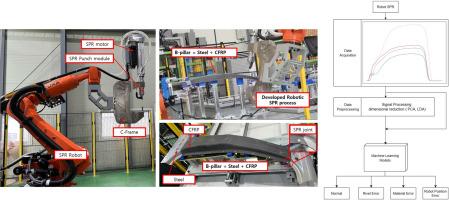Real-time quality classification of robot self-piercing rivet processes in CFRP-steel joints using machine learning
IF 6.8
1区 工程技术
Q1 ENGINEERING, MANUFACTURING
引用次数: 0
Abstract
This study presents a machine learning-based method for real-time quality classification of robotic self-piercing rivet (SPR) processes using pressing force as an input. Unlike previous studies focusing on general SPR processes, this study specifically targets automated robot SPR processes. Data for the study was acquired using a load cell, strain gauge, and accelerometer to develop a nondestructive quality evaluation system for real-time robotic SPR processes. This study introduced an effective and robust data preprocessing method to enhance quality classification by applying signal processing and data dimensionality reduction techniques to pressing force data. While recent advances in deep learning and machine learning have explored various complex networks to improve performance, research specifically addressing the quality of automated robot SPR processes remains limited. Although robotic SPR quality classification may appear similar to conventional SPR quality assessment, the data input differs significantly owing to the vibrations generated by industrial robots. These vibrations reduce the effectiveness of conventional classification methods, making accurate quality assessment more challenging. To address these challenges, six relatively simple yet effective machine learning algorithms were employed to demonstrate the advantages of the preprocessed features of the robotic SPR process, and the optimal algorithm was selected by comparing these algorithms. The proposed method was validated using real SPR data from two automotive production lines. By combining time-domain, processed, and dimensional reduced features from pressing force data, the machine learning model achieved 99.6 % accuracy in real-time SPR quality classification. This confirms its effectiveness and reliability for use in robotic manufacturing environments.

基于机器学习的cfrp -钢连接机器人自穿铆钉工艺质量实时分类
本研究提出了一种基于机器学习的方法,用于机器人自穿孔铆钉(SPR)工艺的实时质量分类,使用压力力作为输入。与以往的研究关注一般的SPR过程不同,本研究专门针对自动化机器人SPR过程。该研究的数据是通过称重传感器、应变计和加速度计获得的,用于开发实时机器人SPR过程的无损质量评估系统。本研究提出了一种有效且稳健的数据预处理方法,将信号处理和数据降维技术应用于冲压力数据,以提高质量分类。虽然深度学习和机器学习的最新进展已经探索了各种复杂的网络来提高性能,但专门针对自动化机器人SPR过程质量的研究仍然有限。尽管机器人SPR质量分类可能与传统的SPR质量评估相似,但由于工业机器人产生的振动,数据输入显着不同。这些振动降低了传统分类方法的有效性,使准确的质量评估更具挑战性。为了解决这些问题,采用6种相对简单但有效的机器学习算法来展示机器人SPR过程预处理特征的优势,并通过比较这些算法来选择最优算法。利用两条汽车生产线的实际SPR数据对该方法进行了验证。通过结合冲压力数据的时域特征、处理特征和降维特征,机器学习模型在实时SPR质量分类中达到了99.6%的准确率。这证实了其在机器人制造环境中使用的有效性和可靠性。
本文章由计算机程序翻译,如有差异,请以英文原文为准。
求助全文
约1分钟内获得全文
求助全文
来源期刊

Journal of Manufacturing Processes
ENGINEERING, MANUFACTURING-
CiteScore
10.20
自引率
11.30%
发文量
833
审稿时长
50 days
期刊介绍:
The aim of the Journal of Manufacturing Processes (JMP) is to exchange current and future directions of manufacturing processes research, development and implementation, and to publish archival scholarly literature with a view to advancing state-of-the-art manufacturing processes and encouraging innovation for developing new and efficient processes. The journal will also publish from other research communities for rapid communication of innovative new concepts. Special-topic issues on emerging technologies and invited papers will also be published.
 求助内容:
求助内容: 应助结果提醒方式:
应助结果提醒方式:


